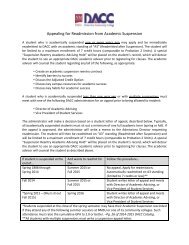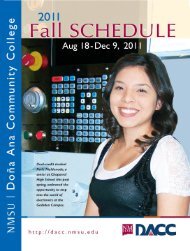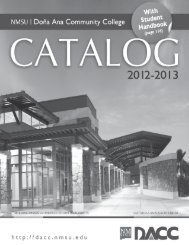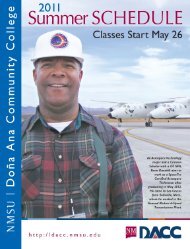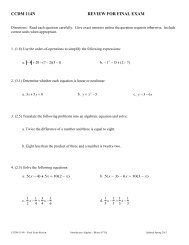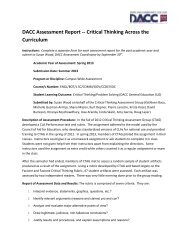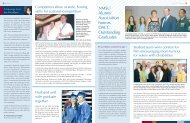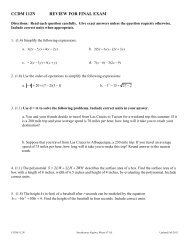STRATEGIC PLAN - Dona Ana Community College
STRATEGIC PLAN - Dona Ana Community College
STRATEGIC PLAN - Dona Ana Community College
You also want an ePaper? Increase the reach of your titles
YUMPU automatically turns print PDFs into web optimized ePapers that Google loves.
N M S U | D o ñ a A n a C o m m u n i t y C o l l e g e<br />
<strong>STRATEGIC</strong> <strong>PLAN</strong><br />
Shaping Doña <strong>Ana</strong> <strong>Community</strong> <strong>College</strong>’s Future:<br />
A Best Practices<br />
Approach to<br />
Student Success<br />
2012-2016
Mission, Vision and Values<br />
Mission Statement<br />
DACC is a responsive and accessible learning‐centered community college that provides educational opportunities to<br />
a diverse community of learners in support of workforce and economic development.<br />
Vision Statement<br />
DACC will be a premier learning college that is grounded in academic excellence and committed to fostering lifelong<br />
learning and active, responsible citizenship within the community.<br />
Values Statement<br />
As a learning‐centered community college, DACC is committed to the following core values:<br />
Education that —<br />
<br />
<br />
<br />
<br />
<br />
offers lifelong learning opportunities<br />
fosters dynamic learning environments designed to meet the needs of our students<br />
guarantees equality of rights and access<br />
ensures integrity and honesty in the learning process<br />
provides comprehensive assessment of learning<br />
Students who will be —<br />
<br />
<br />
<br />
<br />
respected for their diversity<br />
provided with a safe and supportive learning environment<br />
challenged to become critical and independent thinkers<br />
expected to take an active role in their learning process<br />
Employees who —<br />
<br />
<br />
<br />
<br />
<br />
<br />
practice tolerance and inclusiveness in decision‐making and shared governance<br />
encourage and support professional growth<br />
demonstrate high ethics and integrity<br />
encourage collaborative interaction among faculty and staff<br />
practice responsible fiscal management and personal accountability<br />
ensure equal opportunities for a diverse faculty and staff<br />
Communities that —<br />
<br />
<br />
<br />
build partnerships, including educational alliances<br />
strengthen industry partnerships to provide workforce development services and programs in support of<br />
economic development<br />
develop and adapt instructional programs in response to changing economic needs
DACC July 2012‐ June 2016 Strategic Plan<br />
Strategic Priority 1: Improve Student Success<br />
Strategic Priority 2: Intrusive Student and Academic Support Services<br />
Strategic Priority 3: Academic Curriculum Development and Redesign<br />
Strategic Priority 4: Workforce for the Future<br />
Strategic Priority 5: Institutional Efficiency, Effectiveness, and Resource<br />
Management<br />
Strategic Plan Implementation Team<br />
Margie Huerta - President (Chair)<br />
John Walker – Interim VP Academic Affairs<br />
Ike Ledesma - VP Student Services<br />
Andy Burke – VP Business and Finance<br />
John Walker - AVP Academic Affairs<br />
Fred Lillibridge - AVP for Accreditation, Compliance and Planning<br />
Lydia Bagwell – Dean, Business and Information Systems<br />
Bernard Pina - Dean, General Studies<br />
Rebecca Kongs – Interim Dean, Technical Studies<br />
Evelyn Hobbs – Dean, Health and Public Services<br />
Bill Glenn - Executive Director, Workforce Center/Continuing Education<br />
Strategic Priority Implementation Teams<br />
SP-1 Ike Ledesma (Chair)<br />
SP-2 Fred Lillibridge (Chair)<br />
SP-3 Shakir Manshad (Chair)<br />
SP-4 Tim Briggs (Chair)<br />
SP-5 Tammy Powers (Chair)<br />
Shannon Bradley (Associate Chair)<br />
Brad Mazdra (Associate Chair)<br />
Luis Meza (Associate Chair)<br />
Chipper Moore (Associate Chair)<br />
Nancy Ritter (Associate Chair)<br />
2012‐2016 Doña <strong>Ana</strong> <strong>Community</strong> <strong>College</strong> Strategic Plan 8 May 2013 DRAFT<br />
Page | 2
Strategic Priority 1: Improve Student Success<br />
Improve Student Achievement Key Performance Indicators<br />
Required Compliance Metrics<br />
NMCCPBI #1: i Percent of new students taking nine or more credit hours who are successful<br />
after three years FY14 Target = 48.0%<br />
NMCCPBI #4: Percent of Hispanic graduates FY14 Target = 62.5%<br />
NMCCPBI #8: Percent of new students persisting from fall to spring semesters FY14 Target = 81.0%<br />
NMCCPBI #10: Percent of full‐time, first‐time degree seeking students who complete the<br />
program within 150% of normal completion time FY14 Target = 15.0%<br />
Objective GC1 Increase Graduation and Completion<br />
KPI 1.1 Number of Associate Degrees (IPEDS) FY16 Target = 900<br />
KPI 1.2 Number of Career‐Technical Associate Degrees FY16 Target = 400<br />
KPI 1.3 Number of Certificates – Less than one year (IPEDS) FY16 Target = 175<br />
KPI 1.4 Number of Career‐Technical Certificates – Less than one year (IPEDS) FY16 Target = 150<br />
KPI 1.5 Number of Certificates – One year to less than two years (IPEDS) FY16 Target = 800<br />
KPI 1.6 Number of Career‐Technical Certificates – One year to LT two years (IPEDS) FY16 Target = 500<br />
KPI 1.7 Number of reported Industry Recognized Credentials (Perkins) FY16 Target = 1500<br />
KPI 1.8 IPEDS Three‐Year Graduation Rate FY16 Target = 15%<br />
KPI 1.9 IPEDS Four‐Year Graduation Rate FY16 Target = 25%<br />
KPI 1.10 IPEDS Fall to Fall Full‐time Retention Rate FY16 Target = 67%<br />
KPI 1.11 IPEDS Fall to Fall Part‐time Retention Rate FY16 Target = 45%<br />
KPI 1.12 Credit <strong>College</strong>‐level Retention – Enrollee Success Rate (NCCBP ii Form 7) FY16 Target = 77%<br />
KPI 1.13 Credit <strong>College</strong>‐level Retention – Completer Success Rate (NCCBP Form 7) FY16 Target = 83%<br />
KPI 1.14 Number of student seatcount completed in LCs/Paired classes FY16 Target = 2000<br />
KPI 1.15 Number of student seatcount completed in accelerated developmental classes FY16 Target = 1800<br />
KPI 1.16 Number of students passing Math Fast Track workshops To be determined<br />
KPI 1.17 Number of students passing English Fast Track workshops To be determined<br />
Strategy GC1.1 Enhance Student Learning<br />
Action GC1.1A Expand Supplemental instruction to more sections and students.<br />
VPAA/Academic Deans<br />
Action GC1.1B Expand and refine tutoring services offered by the Student Success Center.<br />
VPAA/AVPAA/SSC Director/Academic Deans<br />
Action GC1.1C Assign responsibilities for coordinating the Learning Communities to a faculty member.<br />
President/VPAA<br />
Action GC1.1D Increase the number of sections offered in Learning Communities (LCs) and Paired Classes.<br />
VPAA/Learning Communities Coordinator<br />
2012‐2016 Doña <strong>Ana</strong> <strong>Community</strong> <strong>College</strong> Strategic Plan 8 May 2013 DRAFT<br />
Page | 3
Action GC1.1E Increase the number of students who take developmental Math Fast Track workshops.<br />
GS Dean/Math Fast Track Coordinator<br />
Action GC1.1F Increase the number of students who take developmental English Fast Track workshops.<br />
GS Dean/English Fast Track Coordinator<br />
Action GC1.1G Increase the number of students who declare Career‐Technical program majors.<br />
VPAA/Career‐Technical Deans<br />
Objective GC2 Increase Transfers<br />
KPI 1.18 Number of DACC graduates who enroll at NMSU (Transfers) FY16 Target = 350<br />
KPI 1.19 Number of students transferring to another institution, not NMSU To be determined<br />
Strategy GC2.1 Implement Transfer Initiative<br />
Action GC2.1A Expand participation of expected DACC graduates in the Annual Transfer Fair to encourage them to<br />
transfer to NMSU.<br />
VPSS/Academic Advisors/NMSU Academic Deans<br />
Action GC2.1B Track students who transferred to NMSU or another institution. Consider defining transfer to NMSU<br />
as taking three or more courses only offered at NMSU Las Cruces Campus while or after taking DACC<br />
courses. Identify method to track students who enroll at another institution after leaving DACC.<br />
Admissions Director<br />
Objective GC3 Increase Transitions<br />
KPI 1.20 Credit Dev. Retention, Success, First <strong>College</strong> Level – Writing Completer<br />
Success Rate (NCCBP Form 9) FY16 Target = 82%<br />
KPI 1.21 Credit Dev. Retention, Success, First <strong>College</strong> Level – Math Completer<br />
Success Rate (NCCBP Form 9) FY16 Target = 88%<br />
KPI 1.22 Percentage of ‘W’ grades (HED course completion) FY16 Target = 8%<br />
KPI 1.23 Number of supplemental instruction supported sections offered FY16 Target = 25<br />
KPI 1.24 Number of subjects/topics tutored by Student Success Center FY16 Target = 30<br />
KPI 1.25 Number of DACC seatcount completed by dual credit students FY16 Target = 3500<br />
KPI 1.26 Number of dual credit graduates who are admitted and enroll at DACC FY16 Target = 500<br />
KPI 1.27 Number of DACC credits passed by APECHS students FY16 Target = 2500<br />
KPI 1.28 Five‐year graduation rate of APECHS Freshmen class To be determined<br />
KPI 1.29 Number of APECHS graduates who are admitted and enroll at NMSU To be determined<br />
KPI 1.30 Number of Adult Education students who are admitted and enroll at DACC FY16 Target = 250<br />
KPI 1.31 High School Graduates, % Enrolling Public High School (NCCBP Form 13B) FY16 Target = 29%<br />
Strategy GC3.1 Implement Transition Initiative<br />
Action GC3.1A Accelerate the successful progression from developmental to college‐level credit courses.<br />
WVPAA/GS Dean/GS Department Chairs<br />
Action GC3.1B Recruit current DACC Adult Education students to stay in the college, and advise these students to<br />
successfully transition into available DACC credit programs. The annual transition fair at DACC can be<br />
used to accomplish both of these objectives.<br />
VPSS/WDT Director<br />
2012‐2016 Doña <strong>Ana</strong> <strong>Community</strong> <strong>College</strong> Strategic Plan 8 May 2013 DRAFT<br />
Page | 4
Action GC3.1C Provide information and/ or workshops to current dual credit students outside of the normal<br />
advisement schedule.<br />
VPSS/Dual Credit Director<br />
Action GC3.1D Expand the number of DACC courses offered to Arrowhead Park ECHS students.<br />
VPAA/Academic Deans<br />
Action GC3.1E Establish effective procedures to recruit and advise Arrowhead Park ECHS students to enroll at DACC.<br />
VPSS<br />
2012‐2016 Doña <strong>Ana</strong> <strong>Community</strong> <strong>College</strong> Strategic Plan 8 May 2013 DRAFT<br />
Page | 5
Strategic Priority 2 Intrusive Student and Academic Support Services<br />
Intrusive Student and Academic Support Services Key Performance Indicators<br />
Required Compliance Metrics<br />
NMCCPBI #3: Percent of male students enrolled FY14 Target = 45%<br />
NMCCPBI #6: Number of students enrolled in Adult Education FY14 Target = 5000<br />
Objective SS1<br />
Provide Intrusive Student Services<br />
KPI 2.1 Number of Stop‐out students recovered within one year FY16 Target = 400<br />
KPI 2.2 Number of Students who are Undecided Majors FY16 Target = 1200<br />
KPI 2.3 System Three Year Financial Aid Default Rate FY16 Target = 16%<br />
KPI 2.4 Number of students who complete the FAFSA To be determined<br />
KPI 2.5 Number of New Students who receive loans who complete mandatory entrance<br />
loan counseling<br />
To be determined<br />
KPI 2.6 Number of degree/certificate candidates who receive student loans that<br />
complete mandatory exit loan counseling<br />
To be determined<br />
KPI 2.7 Number of New Students who complete mandatory freshman orientation To be determined<br />
Strategy SS1.1 Identify, contact and track stop‐out students<br />
Action SS1.1A<br />
Action SS1.1B<br />
Action SS1.1C<br />
Action SS1.1D<br />
Action SS1.1E<br />
Send letters and email to students in stop‐out or group or cohort and provide follow‐up advisement.<br />
Personnel from each campus will be responsible for the students who are in the stop‐out group or<br />
cohort from their campus.<br />
Admissions Director/Volunteers from satellite campuses<br />
Provide follow‐up advisement and an exit process for all students. Survey all exiting students to find<br />
out how well DACC meets student needs. Identify if the student intends to transfer. Students from<br />
satellite campuses will be contacted by satellite personnel.<br />
Admissions Director/Volunteers from satellite campuses<br />
Advisors will have course schedule including online, evening and weekend offerings before outreach<br />
to stop‐out cohort or group. Department Chairs and Program Directors should be made aware of the<br />
demand for needs of the stop‐out cohort or group if demand is high in this area so that more courses<br />
can be offered during these time periods.<br />
Admissions Director<br />
Develop a scholarship or other source of funding to pay for tuition for students who have 12 credits<br />
or less remaining to complete degree requirements. The funding would be limited to degree<br />
requirements.<br />
Admissions Director<br />
Monitor degree programs to ensure that courses are offered in a sequence and time that allow<br />
students to complete degrees in appropriate time intervals.<br />
VPAA/Division Deans/OIEP<br />
2012‐2016 Doña <strong>Ana</strong> <strong>Community</strong> <strong>College</strong> Strategic Plan 8 May 2013 DRAFT<br />
Page | 6
Strategy SS1.2 Encourage undecided students to declare major<br />
Action SS1.2A<br />
Action SS1.2B<br />
Action SS1.2C<br />
Action SS1.2D<br />
Action SS1.2E<br />
Action SS1.2F<br />
Send letters and email to students in cohort or group and provide follow‐up academic advising.<br />
Academic Advising Director<br />
Conduct workshops to help students choose a major.<br />
Academic Advising Director<br />
Implement a detailed Banner code for the student’s terminal academic major.<br />
Academic Advising Director<br />
Partner with Career Services and/or Counseling to teach students how selection of a major can be<br />
driven by career preference.<br />
Academic Advising Director<br />
Work with ICT to develop a system to prompt students periodically when in self‐service Banner to<br />
update their contact information and major. This can be done in the click‐wrap agreement or upon<br />
login at pre‐determined intervals.<br />
Academic Advising Director<br />
Identify students who have earned the required credits to be awarded a degree or certificate and<br />
automatically grant the degree or certificate.<br />
Academic Advising Director<br />
Strategy SS1.3 Enhance Financial Aid Education and Communication<br />
Action SS1.3A<br />
Action SS1.3B<br />
Action SS1.3C<br />
Action SS1.3D<br />
Action SS1.3E<br />
Objective SS2<br />
Develop preemptive activities/workshops that educate new students currently receiving financial aid<br />
about required completion rate, GPA, and time frames.<br />
Financial Aid Director<br />
Develop activities to better educate current students about the requirements to maintain financial<br />
aid.<br />
Financial Aid Director<br />
Develop strategies to enhance communication with students regarding completion of the financial<br />
aid application.<br />
Financial Aid Director<br />
Develop activities that educate students currently on SAP about the requirements to maintain or<br />
reestablish receiving financial aid.<br />
Financial Aid Director<br />
Develop activities that educate students about management of student debt after graduation.<br />
Financial Aid Director<br />
Provide Academic Support Services<br />
KPI 2.8 Number of Advised Students To be determined<br />
KPI 2.9 Number of Financial Aid Students who are advised To be determined<br />
KPI 2.10 Number of Academic Early Alert Systems Interventions To be determined<br />
KPI 2.11 Increase Student Satisfaction of Student and Academic Support Services To be determined<br />
2012‐2016 Doña <strong>Ana</strong> <strong>Community</strong> <strong>College</strong> Strategic Plan 8 May 2013 DRAFT<br />
Page | 7
Strategy SS2.1 Advise more students<br />
Action SS2.1A<br />
Action SS2.1B<br />
Action SS2.1C<br />
Provide new student orientations.<br />
Admissions Director<br />
Provide a variety of student counseling workshops.<br />
Counselor<br />
Provide a variety of student career counseling workshops.<br />
Counselor<br />
Strategy SS2.2 Implement an Academic Early Alert System<br />
Action SS2.2A<br />
Action SS2.2B<br />
Provide faculty a mechanism to report students who are not attending classes (NMSU Link).<br />
Academic Advising Director<br />
Conduct workshops on choosing a major.<br />
Academic Advising Director<br />
Strategy SS2.3 Increase Tutoring<br />
Action SS2.3A<br />
Increase student visits to the Student Success Center.<br />
SSC Director/Division Deans<br />
Strategy SS2.4 Enhance the First Year Student Experience<br />
Action SS2.4A<br />
Action SS2.4B<br />
Action SS2.4C<br />
Objective SS3<br />
Develop First Year Student Success Plan.<br />
VPSS/VPAA<br />
Develop intrusive student success activities for first year student cohort.<br />
VPSS/VPAA<br />
Create First‐Year Student Experience Committee.<br />
President<br />
Provide Student Academic Preparation<br />
Strategy SS3.1 Assess Student Preparation<br />
Action SS3.1A<br />
Action SS3.1B<br />
Action SS3.1C<br />
Action SS3.1D<br />
Provide new students information and access to prepare for taking COMPASS.<br />
Admissions Director<br />
Assess potential challenges to new students via application, survey or supplemental interview.<br />
Admissions Director<br />
Assess student competencies using ACT WorkKeys.<br />
Career‐Technical Division Deans<br />
Create or purchase computerized assessment testing instruments to identify level of computer<br />
literacy.<br />
Division Deans/VPAA<br />
2012‐2016 Doña <strong>Ana</strong> <strong>Community</strong> <strong>College</strong> Strategic Plan 8 May 2013 DRAFT<br />
Page | 8
Objective SS4<br />
Enhance Student Advising<br />
Strategy SS4.1 Provide Intrusive Academic Advising Strategies<br />
Action SS4.1A<br />
Action SS4.1B<br />
Action SS4.1C<br />
Provide follow‐up academic advising.<br />
Academic Advising Director<br />
Provide mandatory academic advising for all freshmen with 0‐27 credit hours earned.<br />
Academic Advisors/VPSS/Academic Advising Director<br />
Invite faculty members from academic divisions to attend NMSU Academic Advisor Academy (AAA)<br />
events and DACC Academic Advising Council meetings. The AAA sponsors trainings for academic<br />
advisors to enhance their practice.<br />
Faculty<br />
Action SS4.1D Record professional academic advising contact notes on SPACMNT to provide a standardized<br />
measure for reporting advising contacts.<br />
Academic Advisors/VPSS/Academic Advising Director<br />
Action SS4.1E<br />
Make it very easy for students to find and access academic advisors. Improve efficiency by<br />
consolidating one team of academic advisors in one place on each campus.<br />
Academic Advisors/VPSS/Academic Advising Director<br />
Action SS4.1F Create a degree completion monitoring system to automatically identify students who are eligible for<br />
a degree or certificate.<br />
VPSS/Academic Advising Director/OIEP<br />
2012‐2016 Doña <strong>Ana</strong> <strong>Community</strong> <strong>College</strong> Strategic Plan 8 May 2013 DRAFT<br />
Page | 9
Strategic Priority 3: Academic Curriculum Development and Redesign<br />
Academic Curriculum Development and Redesign Key Performance Indicators<br />
Required Compliance Metrics<br />
CP 1P1 iii Technical Skills Attainment FY14 Target = 98.29<br />
Objective CD1 Redesign Academic Curriculum Strategy 1<br />
Enhance the first‐<br />
KPI 3.1 Credit Developmental Retention, Success – Math Retention Rate<br />
(NCCBP Form 8) FY16 Target = 92<br />
KPI 3.2 Credit Developmental Retention, Success – Writing Retention Rate<br />
(NCCBP Form 8) FY16 Target = 92<br />
KPI 3.3 Credit Dev. Retention, Success, First <strong>College</strong> Level – Math Retention Rate<br />
(NCCBP Form 9) FY16 Target = 93<br />
KPI 3.4 Credit Dev. Retention, Success, First <strong>College</strong> Level – Writing Retention Rate<br />
(NCCBP Form 9) FY16 Target = 97<br />
KPI 3.5 Number of CNA certificates awarded per year FY16 Target = 250<br />
KPI 3.6 Number of CMT certificates awarded per year FY16 Target = 10<br />
KPI 3.7 Number of EMS certificates awarded per year FY16 Target = 90<br />
KPI 3.8 Number of students who successfully complete accelerated courses FY16 Target = 1000<br />
Strategy CD1.1 Redesign Developmental Education<br />
Action CD1.1A Assess effectiveness of COMPASS cut‐off scores for appropriate placement into developmental<br />
education courses with emphasis on Math courses. Offer other placement options including high<br />
school GPAs and allow students an additional or optional paper/pencil assessment.<br />
VPAA/GS Dean/GS Department Chairs/Development Education faculty<br />
Action CD1.1B Expand developmental Math Fast Track progression opportunities, including fast tracking a<br />
developmental math course with a technical math course.<br />
VPAA/GS Dean/GS Department Chairs/Development Education faculty<br />
Action CD1.1C Expand developmental English Fast Track progression opportunities.<br />
VPAA/GS Dean/GS Department Chairs/Development Education faculty<br />
Action CD1.1D Institutionalize the Fast Track Workshop model in order for students to spend less time in<br />
developmental courses. Expand and improve recruitment of county students to attend DACC and<br />
workshops. Teach study skills and test taking skills to Fast Track Workshop student cohort<br />
participating in workshops. Provide advising to cohort. Provide mentoring and tutoring to cohort in<br />
following semester developmental course. Continue to track students to learn how fast they are<br />
moving through the developmental course sequences.<br />
VPAA/GS Dean/GS Department Chairs/Development Education faculty<br />
Action CD1.1E Propose intervention developmental education classes. Have students finish developmental courses<br />
in two semesters. Consider providing more sections of CCDM 112N/113N. Utilize CCDM 105N =<br />
(CCDM 100N & 103N). Increase Accelerated and Integrated Courses including: CCDM 103N & 114N‐<br />
Accelerated; CCDM 114N & Math 120G‐Accelerated; and CCDM 114N & Math 120G‐Integrated; and<br />
2012‐2016 Doña <strong>Ana</strong> <strong>Community</strong> <strong>College</strong> Strategic Plan 8 May 2013 DRAFT<br />
Page | 10
use a Math Emporium Model. Create integrated courses including a development course with a<br />
technical course. Increase the number of CCDE 105N Summer Fast Track workshops from three or<br />
four by Summer 2014. Develop and implement at least one CCDE 110N Fast Track workshop by<br />
2014. Identify ways in which faculty can Fast Track students seamlessly from CCDE 105N and CCDE<br />
110N into sections of CCDE 110N and/or ENGL 111G.<br />
VPAA/GS Dean/GS Department Chairs/Development Education faculty<br />
Action CD1.1F Increase instructional support for developmental students. Provide necessary guidance for learning<br />
and practicing the math concepts. Dedicate a “Math Learning Lab” room with computers and tables<br />
for these activities. Consider assigning supplemental instruction leader to mentor, proctor<br />
performance of students and conduct focus groups with students for feedback on consistent basis.<br />
VPAA/GS Dean/GS Department Chairs/Development Education faculty<br />
Action CD1.1G Expand Supplemental Instruction (SI) for developmental education classes. For <strong>College</strong>/Life Success<br />
COLL 101: offer several sections of COLL 101 online (1 Credit) by AY 2014; offer more sections in the<br />
summer for incoming freshmen by Summer 2014; and require mandatory placement for ‘at risk’<br />
students by AY 2014. For Math/English Supplemental COLL 155: Have course specific sections, one<br />
for Math and one for English faculty by Spring 2014; offer at least one section at East Mesa Campus<br />
and one at Central Campus; designate an area or room as a Supplemental Instruction Lab where<br />
students can go to fulfill the course requirements by May 2014. For General Supplemental<br />
Instruction MATH 101: advise/target students who just finished CCDM 114N with a C average to<br />
enroll into MATH 120/101 courses by May 2014.<br />
VPAA/GS Dean/GS Department Chairs/Development Education faculty<br />
Action CD1.1H Reestablish and redeploy the work of the Jump Start Committee to provide “Jump Start” education<br />
workshops to be offered to students during first week of every semester to provide specific skills<br />
development.<br />
Faculty/Staff/Administrators (as appropriate)<br />
Action CD1.1I<br />
Establish the DACC Intervention Center. It would house a classroom, tutoring and computers linked<br />
directly to curricular interventions and innovations at the college. The proposed space will also<br />
facilitate faculty participation in such interventions. The dedicated space will house offices, planning<br />
spaces, the opportunity to collect rich data, and anticipate solutions to problems as they arise.<br />
Faculty/Staff/Administrators (as appropriate)<br />
Strategy CD1.2 Redesign Distance Education<br />
Action CD1.2A Develop new and redesign current online instruction curriculum. Online faculty need to merge their<br />
content expertise with online teaching pedagogy. Explore and implement strategies for<br />
communicating technical, usually hands‐on material to students in technical courses. Use Quality<br />
Matters (QM) to benefit both individual faculty and DACC as a whole to: improve student learning<br />
outcomes and retention; incorporate new technologies and research findings; engage in<br />
benchmarking activities with peer institutions; provide ongoing faculty professional development and<br />
increase flexibility, creativity, divergent thinking, and efficiency in using institutional resources.<br />
VPAA/AVPAA/Academic Deans/Academic Department/Program Chairs/Distance Education faculty<br />
Action CD1.2B Develop procedures to enhance the academic integrity of online classes. VLIT will provide faculty<br />
training in test creation and alternative assessments. VLIT and Student Services will develop and<br />
provide student training in plagiarism and ethics.<br />
VPAA/AVPAA/Academic Deans/Academic Department and Program Chairs/Distance Education<br />
faculty/VLIT/VPSS<br />
2012‐2016 Doña <strong>Ana</strong> <strong>Community</strong> <strong>College</strong> Strategic Plan 8 May 2013 DRAFT<br />
Page | 11
Action CD1.2C Improve instruction in the Virtual Learning Environment by establishing procedures and guidelines to<br />
implement an effective assessment process for quality control of online courses. Instructors: will<br />
pilot online course check list; offer QM based professional development and other online education<br />
professional development. Academic Supervisors: will evaluate an instructor’s face‐2‐face course<br />
and, after training, will also evaluate online courses. VLIT: will request permission to hire a QM<br />
Coordinator based on NMSU Alamogordo’s new position to develop and maintain the QM Peer<br />
Review process for online courses and will evaluate all online courses by 2016 using QM Rubric or<br />
college created equivalent. DACC: will support numerous faculty members to become certified peer<br />
reviewers and support VLIT with in‐house QM Peer Reviews and will support Professional<br />
Development for online educators.<br />
VPAA/AVPAA/Academic Deans/Academic Department and Program Chairs/Distance Education<br />
faculty/VLIT<br />
Action CD1.2D Implement a Learning Management System certification process for all faculty members who teach<br />
online. VLIT will continue to provide Canvas Certification and Canvas Student Training for online<br />
faculty. VLIT will develop levels of online training for faculty to address specific needs of online,<br />
blended, and web‐enhanced classrooms and will create a mandatory Student Canvas Training to test<br />
student readiness.<br />
VPAA/AVPAA/Academic Deans/Academic Department and Program Chairs/Distance Education<br />
faculty/VLIT<br />
Action CD1.2E Establish an Online Education Committee to offer improvement suggestions. An Online Education<br />
Committee will be created for Fall 2013. Members will include: interested members from SP6,<br />
representatives from all Divisions, and interested faculty, staff, and administrators.<br />
President/VPAA/AVPAA<br />
Strategy CD1.3 Redesign Dual Credit and Early <strong>College</strong> High School Education<br />
Action CD1.3A Develop new and redesign old dual credit instruction curriculum. Clearly define career pathways so<br />
students can earn certificates. Allow students to take general education courses to encourage more<br />
dual credit students to continue their education at DACC. Make COLL 101 a mandatory class for new<br />
dual credit students. Provide more advising support for dual credit students.<br />
VPAA/AVPAA/Academic Deans/Academic Department and Program Chairs/Dual Credit Education<br />
faculty<br />
Action CD1.3B Increase educational partnerships and linkages with high schools and post‐secondary education<br />
programs through the expansion of recruitment and outreach activities such as GEAR UP, Regional<br />
Education Initiative, technical workforce‐related summer camps (such as architecture and game<br />
design camps) and dual credit programs in order to create a seamless educational (K‐20) system.<br />
Establish more consistency among participating school districts. Increase the number of careertechnical<br />
courses and general education courses for dual credit students.<br />
VPAA/AVPAA/Academic Deans/Academic Department and Program Chairs/Dual Credit Education<br />
faculty<br />
Action CD1.3C Maintain dual credit eligibility standards and ensure that dual credit students are academically<br />
prepared for college level courses. Continue to recruit, provide COMPASS testing, and advise high<br />
school students.<br />
VPAA/AVPAA/Academic Deans/Academic Department and Program Chairs/Dual Credit Education<br />
faculty<br />
2012‐2016 Doña <strong>Ana</strong> <strong>Community</strong> <strong>College</strong> Strategic Plan 8 May 2013 DRAFT<br />
Page | 12
Objective CD2 Use Instructional Technology to Support Academic ExcellenceStrategy 1 Enhance the first‐<br />
Strategy CD2.1 Establish Instructional Equipment Standards<br />
Action CD2.1A Acquire new equipment. Assess the adequacy of and minimum standards for new acquisition of<br />
technology equipment for the classroom. Newly acquired technical equipment should match<br />
industry standards, follow best practices of operation and use off‐the‐shelf products to ensure<br />
graduating students train with desirable job market skills. Technical equipment purchases must also<br />
support requirements of accreditation or certification of the program(s). All equipment should come<br />
from reputable, well‐established vendors and providers to ensure DACC pays competitive prices and<br />
obtains the best possible warranties and technical support. Some written guidelines for equipment<br />
acquisition should be available and disseminated. Department decision makers should consult such<br />
written guidelines during the acquisition process. The same appropriate guidelines should apply for<br />
donated equipment.<br />
VPBF/VPAA<br />
Action CD2.1B Upgrade existing equipment. Determine the life cycle of equipment by documenting performance<br />
and service record. Anticipate end‐of‐useful‐life well ahead to avoid overuse of antiquated<br />
equipment. Find and evaluate current technological equipment in terms of performance and useful<br />
life. Establish timelines for equipment upgrades to ensure optimal performance and industry<br />
relevance.<br />
VPBF/VPAA<br />
Strategy CD2.2 Establish Equipment Preventative Maintenance Standards<br />
Action CD2.2A Maintain equipment. Find and evaluate current technological equipment in terms of needed or<br />
perceived maintenance operations. Track DACC students who graduate for current employment and<br />
determine whether their skills and familiarity with technological equipment satisfy their employers’<br />
needs. Implement cost‐benefit studies to determine the best maintenance options at different<br />
departments. Such studies must include: original warranties; extended warranties, service<br />
agreements, and pay per maintenance event.<br />
VPBF/VPAA<br />
Objective CD3 Program Accreditation Enhance the first‐<br />
KPI 3.9 Number of Program Accreditations +1 per year<br />
Strategy CD3.1 Encourage academic programs to earn accreditation<br />
Action CD3.1A Develop a plan that would reward programs that seek and obtain program accreditation.<br />
President/VPAA<br />
Strategy CD3.2 Maintain all existing program accreditations<br />
Action CD3.2A Develop a plan that would reward programs with continued accreditation. Rewards could include:<br />
pay incentives for faculty and staff; providing administrative staff support for accredited programs;<br />
and providing budgetary Increases that are tied to accreditation requirements.<br />
President/VPAA<br />
2012‐2016 Doña <strong>Ana</strong> <strong>Community</strong> <strong>College</strong> Strategic Plan 8 May 2013 DRAFT<br />
Page | 13
Action CD3.2B Develop a committee that would bring accredited program faculty together with the<br />
prerequisite/general education programs to assess curricular needs of programs and match those<br />
needs to proper courses.<br />
President/VPAA<br />
Action CD3.2C Develop a standard procedure for maintaining database of dates accredited, renewals, and site visits.<br />
Update administration on program status and needs with supportive documentation of accreditation<br />
standards. This could perhaps be a short end‐of‐year report.<br />
President/VPAA/AVPACP<br />
Action CD3.2D Reaccredit Nursing Program with the National League for Nursing Accrediting Commission (NLNAC).<br />
President/VPAA/Dean H&PS/Nursing Program Director<br />
Action CD3.2E Investigate an expanded system of periodic program review for all programs and units. Programs<br />
with specialized accreditation or certification will be reviewed in advance of self‐study preparation.<br />
VPAA/AVPAA/Deans/OIEP<br />
Strategy CD1.4 Redesign traditional courses to increase retention<br />
Action CD1.4A Redesign traditional courses. Invite faculty to submit proposals to be in the NexGen Faculty Fellows<br />
program. Participating faculty will read the book Next Generation Course Redesign and then,<br />
following the book’s protocols, will redesign one course they teach each year. Faculty may be<br />
awarded a small stipend for participating.<br />
VPAA/AVPAA/Academic Deans/Academic Department and Program Chairs/Full‐ and Part‐time faculty<br />
Action CD1.4B Share new course designs on a website connected to the DACC Assessment of Student Learning<br />
webpage. Connect redesign projects to Promotion and Tenure Teaching and Related Activities<br />
categories.<br />
VPAA/AVPAA/Academic Deans/Academic Department and Program Chairs/Full‐ and Part‐time faculty<br />
Action CD1.4C Develop new methods to track students and measure retention.<br />
VPAA/AVPAA/Academic Deans/Academic Department and Program Chairs/Full‐ and Part‐time<br />
faculty/OIEP<br />
Action CD1.4D Investigate class climate course evaluation feedback system.<br />
VPAA/AVPAA/Deans/OIEP<br />
2012‐2016 Doña <strong>Ana</strong> <strong>Community</strong> <strong>College</strong> Strategic Plan 8 May 2013 DRAFT<br />
Page | 14
Strategic Priority 4: Workforce for the Future<br />
Workforce for the Future Key Performance Indicators<br />
Required Compliance Metrics<br />
NMCCPBI #2: Percent of graduates placed in jobs in New Mexico FY14 Target = 77.0%<br />
NMCCPBI #5: Number of students enrolled in Contract Training FY14 Target = 1,500<br />
NMCCPBI #9: Percent of graduates placed in jobs or continuing education in New Mexico FY14 Target = 87.0%<br />
CP 2P1 Credential, Certificate, or Degree FY14 Target = 50<br />
CP 3P1 Student Retention or Transfer FY14 Target = 85<br />
CP 5P1 Nontraditional Participation FY14 Target = 62<br />
CP 5P2 Nontraditional Completion FY14 Target = 42<br />
Objective WF1 Develop New Workforce 1<br />
KPI 4.1 Number of Career‐Technical Associate Degrees FY16 Target = 400<br />
KPI 4.2 Number of Career‐Technical Certificates – Less than one year (IPEDS) FY16 Target = 150<br />
KPI 4.3 Number of Career‐Technical Certificates – One year to LT two years (IPEDS) FY16 Target = 500<br />
KPI 4.4 Number of reported Industry Recognized Credentials (Perkins) FY16 Target = 1500<br />
KPI 4.5 Number of DACC government, education, and industry partners’ roundtables To be determined<br />
KPI 4.6 Number of SBDC Client Counseling Sessions FY16 Target = 500<br />
Strategy WF1.1 Prepare students to be ready to join the workforce<br />
Action WF1.1A Prepare students for gainful employment.<br />
President/VPAA/Career‐Technical Deans<br />
Action WF1.1B Assess academic programs to determine which need to be modified, updated or discontinued.<br />
Career‐Technical Program Advisory Committees/Lead Instructors/Department Chairs<br />
Action WF1.1C Meet the needs of the labor market by ensuring that all instructional programs, both credit and noncredit,<br />
have working Advisory Councils to promote collaboration and improve programs. All<br />
departments should have advisory board meetings and they should include persons from other<br />
departments, as well as people from industry. Every advisory board should be made up of a variety<br />
of individuals.<br />
Career‐Technical Program Advisory Committees/Lead Instructors/Department Chairs<br />
Strategy WF1.2 Support workforce and economic initiatives throughout the region<br />
Action WF1.2A Understand and be responsive to workforce needs of area employers through community<br />
engagement and regular workforce roundtable meetings.<br />
President/VPAA/C‐T Program Advisory Committees/Lead Instructors/Department Chairs<br />
Action WF1.2B Provide training classes customized to the needs of area employers. These could be continuing<br />
education courses or courses that offer CEU's.<br />
C‐T Lead Instructors/Department Chairs (credit courses) in conjunction with Customized Training<br />
(non‐credit courses)<br />
2012‐2016 Doña <strong>Ana</strong> <strong>Community</strong> <strong>College</strong> Strategic Plan 8 May 2013 DRAFT<br />
Page | 15
Action WF1.2C Continue to provide training and support at the Small Business Development Center. Coordinate<br />
with career‐technical programs to convey what services are offered. Invite a SBDC Representative to<br />
appropriate Advisory Council/Committees Meetings to better promote services offered by SBDC to<br />
area employers and business owners.<br />
C‐T Lead Instructors/Department Chairs<br />
2012‐2016 Doña <strong>Ana</strong> <strong>Community</strong> <strong>College</strong> Strategic Plan 8 May 2013 DRAFT<br />
Page | 16
Strategic Priority 5: Institutional Effectiveness, Efficiency and Resource<br />
Management<br />
Institutional Operational Effectiveness and Efficiency Key Performance Indicators<br />
Required Compliance Metrics<br />
NMCCPBI #7: Percent of programs with stable or increasing enrollment FY14 Target = 91.0%<br />
Objective EF1 Enhance a Culture of Evidence<br />
KPI 5.1 Number of training opportunities offered To be determined<br />
KPI 5.2 Number of employees who participate in orientation FY16 Target = 100%<br />
KPI 5.3 Number of employees who participate in training FY16 Target = 100%<br />
KPI 5.4 Number of SharePoint page views To be determined<br />
Strategy EF1.1 Support data‐informed decision making<br />
Action EF1.1A<br />
Develop data tracking reports to measure student success, e.g. classroom utilization, instructional<br />
efficiency, retention numbers and cost.<br />
OIEP<br />
Activity EF1.1B Enhance sharing approaches to distribute reports.<br />
OIEP/Academic Deans/ALT<br />
Strategy EF1.2 Identify information needs of individuals and units based upon individual and unit needs<br />
Action EF1.2A<br />
Action EF1.2B<br />
Develop and publish information distribution timelines and processes.<br />
OIEP/Academic Deans/ALT<br />
Design information and training sessions to foster the free flow of information and departmental<br />
submission throughout the college community.<br />
OIEP<br />
Objective EF2 Establish and Maintain Effective and Efficient Processes<br />
KPI 5.5 Processing efficiency internal survey workflow To be determined<br />
KPI 5.6 Processing efficiency internal systems To be determined<br />
Strategy EF2.1 Assess and improve processes<br />
Action EF2.1A<br />
Action EF2.1B<br />
Review and monitor existing and emerging technology to improve operational efficiency and existing<br />
administrative processes.<br />
Computer Support/VLIT/OIEP<br />
Survey campus departments for technology needs.<br />
Computer Support/VLIT/OIEP<br />
2012‐2016 Doña <strong>Ana</strong> <strong>Community</strong> <strong>College</strong> Strategic Plan 8 May 2013 DRAFT<br />
Page | 17
Action EF2.1D<br />
Action EF2.1E<br />
Investigate exception software that addresses workflow tracking and efficiency that was developed<br />
by Dr. Jeff Beasley at NMSU.<br />
OIEP/VPSS/Academic Advisors<br />
Investigate an expanded system of periodic program review for all programs and units. Programs<br />
with specialized accreditation or certification will be reviewed in advance of self‐study preparation.<br />
[Same as Action CD3.2E]<br />
VPAA/AVPAA/Deans/OIEP<br />
Strategy EF2.2 Enhance Internal Communications to promote a learning organization<br />
Action EF2.2A<br />
Action EF2.2B<br />
Promote use of SharePoint to current employees for workflow and communication needs.<br />
Computer Support/LLT Division/Deans<br />
Develop process for using SharePoint and keeping information updated across the campus.<br />
Computer Support/LLT Division/Marketing & Development/VPAA<br />
Action EF2.2C Include SharePoint in new employee orientation beginning in Fall 2014.<br />
HR/Computer Support/Administrative Units<br />
Action EF2.2D<br />
Action EF2.2E<br />
Action EF2.2F<br />
Create new employee orientation guide in SharePoint (e.g. Personnel checklist).<br />
Administrative Units/HR/Computer Support<br />
Develop a DACC‐specific employee handbook.<br />
HR/Computer Support/Administrative Units/VPAA<br />
Sustain human resources training efforts with ongoing training initiative (e.g. Harassment training).<br />
HR/Computer Support/Administrative Units<br />
Strategy EF2.3 Enhance External Communications<br />
Action EF2.3A<br />
Action EF2.3B<br />
Action EF2.3C<br />
Support robust CMS system (e.g. from Mango to Word Press) for updating Web content for external<br />
public.<br />
Computer Support/LLT/Deans<br />
Increase the number of publications and related materials that are available in Spanish.<br />
Marketing & Communications<br />
Create process for information to be shared with publications office (e.g. departmental events,<br />
training exercises).<br />
Planning and Development/Marketing & Communications/Deans/Administrative Units<br />
Objective EF3 Increase Funding<br />
KPI 5.7 Amount of Principal Endowment Dollars To be determined<br />
KPI 5.8 Number of Scholarships Funded To be determined<br />
KPI 5.9 Number of DACC staff participating in funding scholarships To be determined<br />
2012‐2016 Doña <strong>Ana</strong> <strong>Community</strong> <strong>College</strong> Strategic Plan 8 May 2013 DRAFT<br />
Page | 18
Strategy EF3.1 Increase aggregate principal amount of endowed scholarship funds<br />
Action EF3.1A<br />
Promote Jon Wynne matching funds to internal and external audiences; develop donor stewardship<br />
program to include regular and targeted communications about specific programs, and promote<br />
current scholarship funds to internal and external audiences.<br />
Planning & Development/Marketing & Communications/Academic Advisors<br />
Strategy EF3.2 Foster a culture of philanthropy to increase funding for programs and student scholarships<br />
Action EF3.2A<br />
Strengthen community stakeholder partnerships, utilize current resources, i.e. program advisory<br />
councils, to engender a spirit of collective giving, and promote an internal appreciation and<br />
participation in giving by DACC faculty and staff.<br />
Planning & Development/Marketing & Communications/Deans/Academic Advisors<br />
Strategy EF3.3 Ensure continued institutional capital funding<br />
Action EF3.3A<br />
Action EF3.3B<br />
Hold local bond issue elections periodically to renew the one‐mill tax levy for capital funding.<br />
President/VPAA/VPSS/VPBF<br />
Annually request capital funding through the State Legislature from general fund appropriations, the<br />
severance tax fund, or state general obligation bonds.<br />
President/VPAA/VPSS/VPBF<br />
Objective EF4 Provide Adequate Facilities<br />
KPI 5.10 Rate of classroom utilization To be developed<br />
KPI 5.11 Decrease energy (electrical) consumption FY16 Target = ‐10%<br />
Strategy EF4.1 Effectively plan for future DACC facilities and space utilization<br />
Action EF4.1A<br />
Action EF4.1B<br />
Action EF4.1C<br />
Gather input and updates for the Facilities Master Plan by utilizing the services of a facilities planner.<br />
Facility Services Manager/VPBF<br />
Utilize a participatory internal process to evaluate, identify, and prioritize space needs for each major<br />
project and to recommend the optimal use for facilities.<br />
Facility Services Manager/VPBF<br />
Perform major repair work on, and/or replace, the heating, ventilation and air conditioning systems,<br />
building interior finishes, and exterior envelopes of older facilities.<br />
Strategy EF5.1 Investigate and implement methods to improve the <strong>College</strong>’s understanding and methods for<br />
environmental sustainability to improve the <strong>College</strong>’s commitment to environmental sustainability<br />
Action EF5.1A<br />
Action EF5.1B<br />
Review current college sustainability activities and develop an improvement plan.<br />
President/VPBF<br />
Investigate the guidelines from the Association for the Advancement of Sustainability in Higher<br />
Educations (AASHE) to assist in the review process and consider membership, also review the NMSU<br />
re‐use initiative.<br />
President/VPBF<br />
2012‐2016 Doña <strong>Ana</strong> <strong>Community</strong> <strong>College</strong> Strategic Plan 8 May 2013 DRAFT<br />
Page | 19
2012‐2016 Doña <strong>Ana</strong> <strong>Community</strong> <strong>College</strong> Strategic Plan 8 May 2013 DRAFT<br />
Page | 20
Action EF5.1C<br />
Action EF5.1D<br />
Action EF5.1E<br />
Advocate for sustainability measures to reduce costs.<br />
President/VPBF<br />
Reduction of travel expenses and motor pool costs by meetings online via conference call technology<br />
and Adobe Connect.<br />
President/VPBF<br />
Reduce office costs by shared purchasing of departmental office supplies, shared promotional items,<br />
and using DACC logo and branding information instead of individual departments.<br />
President/VPBF<br />
Action EF5.1G Reduce printing costs by only providing double‐sided printing options for shared settings, classrooms<br />
and offices, and reviewing free printing measures for students.<br />
President/VPBF<br />
Action EF5.1H Renovate building systems (HVAC and lighting) to provide improved energy efficiency and reduce<br />
costs.<br />
President/VPBF/Facilities Services Manager<br />
Action EF5.1I<br />
Initiate effort to combine classroom outcomes with campus‐wide sustainability efforts, examples<br />
include: solar panels, water conservation, and green buildings.<br />
Facility Services Manager/Deans<br />
i NMCCPBI is New Mexico <strong>Community</strong> <strong>College</strong> Performance Based Indicator. These 10 key performance indicators were created<br />
by the New Mexico Association for <strong>Community</strong> <strong>College</strong>s. They are used to comply with the New Mexico Accountability in<br />
Government Act.<br />
ii NCCBP is the National <strong>Community</strong> <strong>College</strong> Benchmarking Project. Responding to requirements for inter-institutional<br />
comparisons, Johnson County <strong>Community</strong> <strong>College</strong> (KS) established the National <strong>Community</strong> <strong>College</strong> Benchmark Project<br />
(NCCBP) with other colleges from across the United States to standardize a nation-wide benchmark reporting process. Since 2004,<br />
over 450 community colleges have participated in the current data-collection and reporting process. 269 community colleges from<br />
across the United States participated in NCCBP in 2012.<br />
iii CP is Carl Perkins. One of five performance indicators required by the New Mexico Public Education Department to measure<br />
performance on career-technical programs supported by the Carl D. Perkins Vocational and Technical Education Act. The act was<br />
first authorized by the federal government in 1984 and reauthorized in 1998. Named for Carl D. Perkins, the act aims to increase<br />
the quality of technical education within the United States in order to help the economy.<br />
2012‐2016 Doña <strong>Ana</strong> <strong>Community</strong> <strong>College</strong> Strategic Plan 8 May 2013 DRAFT<br />
Page | 21
MSC-3DA . Box 30001 . 3400 South Espina Street . Las Cruces . NM 88003-8001<br />
Telephone: (575) 527-7500 . TTY: (575) 527-7647 . Toll free: (800) 903-7503<br />
http://dacc.nmsu.edu



